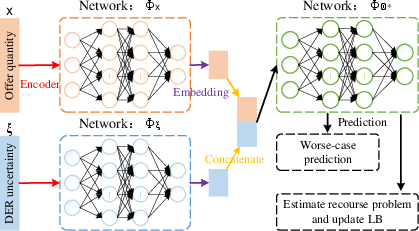- The paper introduces a novel neural network-integrated Column-and-Constraint Generation framework to optimize DER day-ahead offering strategies.
- It combines robust optimization with machine learning to manage uncertainties in market prices and DER generation effectively.
- Empirical results demonstrate up to a 100-fold speedup over traditional solvers, ensuring scalability and real-time application in energy markets.
DER Day-Ahead Offering Optimization with Neural Network CCG
This essay explores the work entitled "DER Day-Ahead Offering: A Neural Network Column-and-Constraint Generation Approach" (2511.12384), in which a novel method is introduced to optimize the offering strategies of Distributed Energy Resource (DER) aggregators in day-ahead energy markets. The research innovatively combines neural networks with classical optimization techniques, specifically a Column-and-Constraint Generation (CCG) approach, to enhance the robustness and efficiency of DER offering strategies under uncertainty.
Introduction to Day-Ahead Offering Challenges
The paper begins by addressing the challenges faced by DER aggregators in the day-ahead electricity market. These aggregators must submit price-quantity pairs, often before uncertainties related to market prices and DER generation are resolved. Traditionally, this problem is tackled using two-stage adaptive robust optimization models, balancing stochastic programming and robust optimization. However, existing methods face scalability issues and are often computationally intensive, particularly in handling complex, large-scale scenario sets associated with uncertainty modeling.
Neural Network-Accelerated CCG Framework
To surmount these challenges, the authors develop a Neural Network (NN)-accelerated CCG framework. This framework is adapted from existing methods to streamline solving the Two-Stage Adaptive Robust Stochastic Optimization (2S-ARSO) model for DER offering:
The paper formulates the DER day-ahead offering problem as a hybrid model leveraging both stochastic and robust optimization principles. In this model, first-stage "here-and-now" decisions regarding price-quantity pairs are made before the realization of uncertainty, while second-stage "wait-and-see" decisions, such as DER dispatch, are made post-uncertainty resolution. The core optimization problem is structured as follows:
- Objective Function: The objective combines first-stage revenues and second-stage recourse costs, with uncertainties in prices and DER generation influencing both.
- Constraint Handling: The CCG algorithm iteratively refines constraints based on worst-case scenarios identified via duality principles, allowing for robust optimization in a computationally feasible manner.
Computational Advantages and Implementation
The NN-accelerated CCG approach demonstrates substantial computational efficiency. Empirical results indicate that this method achieves up to a 100-fold speedup compared to Gurobi and a 33-fold speedup relative to the classical CCG, particularly in large-scale networks with numerous scenarios.
- Performance Metrics: The paper benchmarks the method against traditional solvers, highlighting superior scalability and solution quality, facilitating real-time application in industrial settings.
Implications and Future Research Directions
The proposed NN-enhanced optimization framework sets the stage for more efficient DER market participation strategies. Practically, it accommodates larger, more complex datasets without sacrificing computational tractability. Theoretically, it extends robust optimization's applicability, integrating advanced machine learning techniques into operational planning.
The paper suggests potential expansions, such as applying this framework to different market configurations and exploring additional machine learning models to further improve predictive accuracy and decision-making efficiency.
Conclusion
This paper presents a seminal approach that marries machine learning with optimization in the context of energy markets, providing a robust solution for DER day-ahead offerings. This integration exemplifies a cutting-edge development where neural models not only predict outcomes but actively contribute to optimizing complex decision-making processes in real-world applications.


